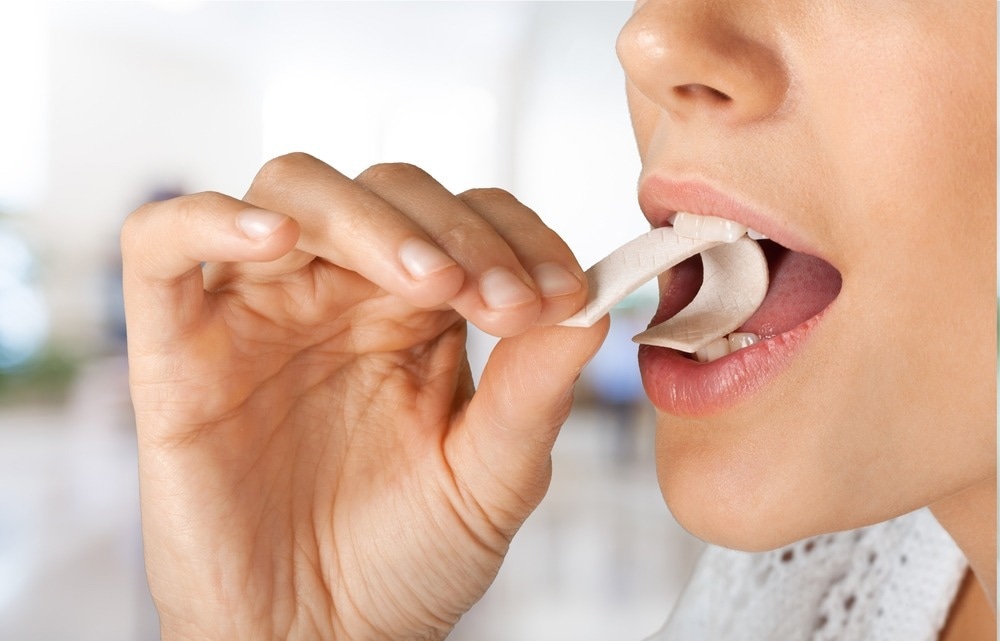The severe acute respiratory syndrome coronavirus 2 (SARS-CoV-2), the causal agent of the coronavirus disease 2019 (COVID-19) pandemic, is predominantly transmitted through aerosols or droplets. These droplets are generated when a person infected with SARS-CoV-2 talks, sneezes, or coughs.

Study: Reduction of SARS-CoV-2 viral load in exhaled air by antiseptic chewing gum: a pilot trial. Image Credit: Billion Photos / Shutterstock.com
Background
The oral cavity plays an important role in SARS-CoV-2 infection, as saliva is a potent route of COVID-19 transmission. Interestingly, viral load in the oral cavity has been linked with disease severity. As a preventive measure, the use of antiseptic mouth rinses has been recommended to reduce the oral viral load.
It was assumed that as compared to mouth rinses, chewing gums and lozenges containing antiseptic compounds would be easier to use. These products can be kept in the oral cavity for a prolonged period, where they could slowly and continuously release active ingredients. To date, several natural compounds exhibit antiseptic properties, which could be utilized in the development of antiviral lozenges or chewing gum.
A recent Infection study determined the effectiveness of antiviral chewing gum in reducing oral viral load in the exhaled air of COVID-19 patients.
About the study
Cycle threshold (Ct) values obtained from polymerase chain reaction (PCR) analysis helped evaluate the viral load in exhaled air of patients infected with SARS-CoV-2. The viral load was measured before and after using an antiseptic chewing gum at different time points.
The chewing gum used in this study is commercially available and contains cinnamon, lemon, and peppermint essential oils, as well as extracts of ginger, ginseng, quercetin, and spermidine.
This pilot study was conducted at the IKF Clinical Research Center Respiratory Diseases, Frankfurt, Germany. The study cohort included participants who tested positive for COVID-19 and were above 18 years of age.
The exhaled air of all the participants was collected. In this process, after maximum inspiration, they were asked to exhale forcefully through their mouths into a container with filter paper. The filter papers were assessed via PCR to estimate Ct values.
Exhaled air samples were collected at different time intervals including before and after 15 minutes of using antiseptic chewing gum. Additional samples were collected 30, 45, 60, 90, and 120 minutes after the collection of the first sample.
Study findings
A total of nine symptomatic COVID-19 patients participated in this pilot trial. Molecular sequencing revealed that four patients were infected with the SARS-CoV-2 ancestral strain, three with the Alpha variant, and two with the Delta variant.
As compared to the Ct value obtained before chewing the gum, an increasing trend was observed in all participants. The mean difference in Ct values before chewing the antiviral chewing gum and 15 minutes after chewing the gum was 3.8.
There was a reduction of 50% in the viral load per 1.0 increase in Ct value. Based on increasing Ct values, a reduction in the viral load was found in the exhaled air for up to 120 minutes. After two hours of chewing the antiseptic chewing gum, the viral load dropped between 84% and 93%.
Oral viral load assessed by measuring the Ct value of the exhaled air of a COVID-19 patient helped determine the degree of infectiousness. Previous in vitro studies have strongly indicated the antiviral effect of the active ingredients, such as ginger extracts, cinnamon oil, spermidine, peppermint oil, citrus oil, quercetin, and ginseng, present in the antiviral chewing gum.
Study limitations
One key limitation of this study is the small number of participants. Furthermore, the efficacy of chewing gum in reducing the viral load was assessed against three types of SAR-CoV-2 variants, while many other SARS-CoV-2 variants have emerged.
The current pilot study was conducted before the incidence of the Omicron variant in Germany, which it is currently the dominant circulating strain and contains many genomic mutations.
Conclusions
The significant reduction in the viral load after 120 minutes of chewing the antiseptic gum indicated a strong antiviral effect against SARS-CoV-2. It is imperative to understand if the active ingredients present in the chewing gum were responsible for the reduction of viral load or if increased saliva production had diluted or decreased viral load.
Nevertheless, the authors suspect that the active ingredients, rather than of increased saliva production, reduced oral viral load. In the future, large placebo-controlled clinical trials are needed to validate the findings of the current study.
Journal reference:
- Pfab, F., Buelow-Johansen, B., Alber, D. et al. (2022) Reduction of SARS-CoV-2 viral load in exhaled air by antiseptic chewing gum: a pilot trial. Infection. doi:10.1007/s15010-022-01944-2